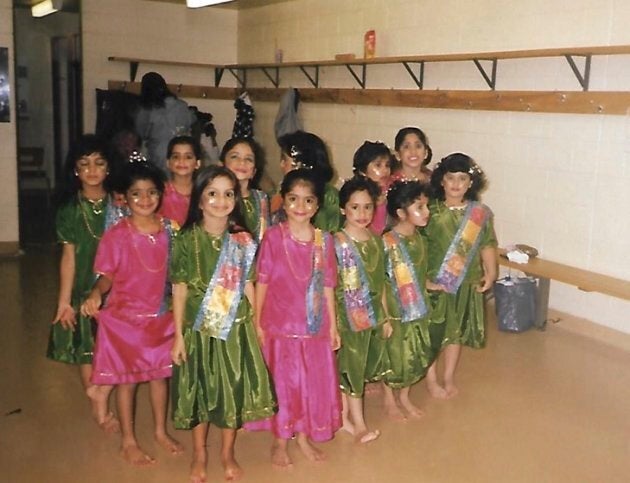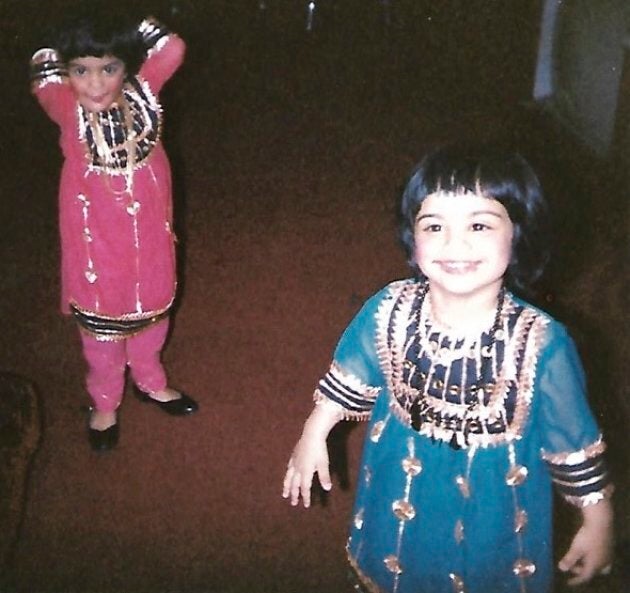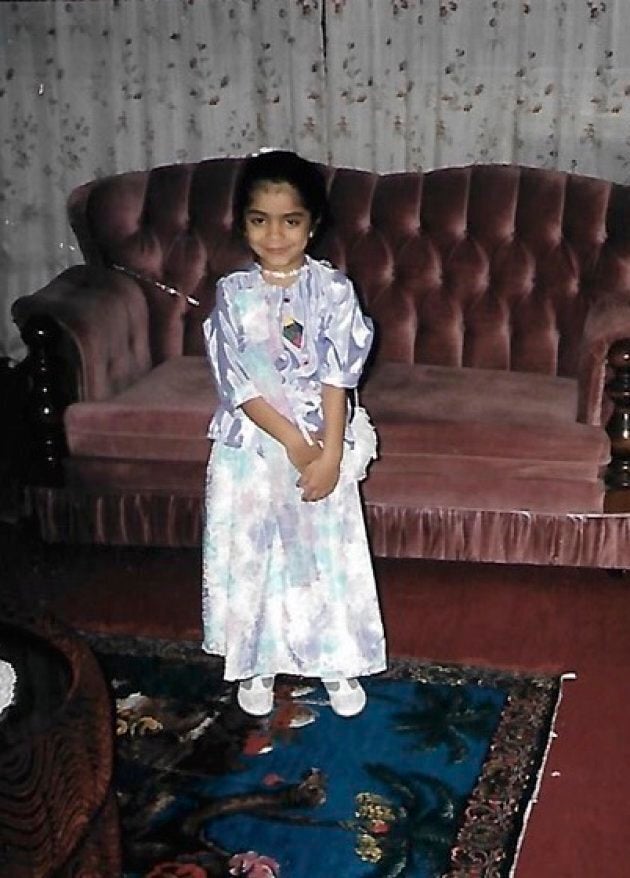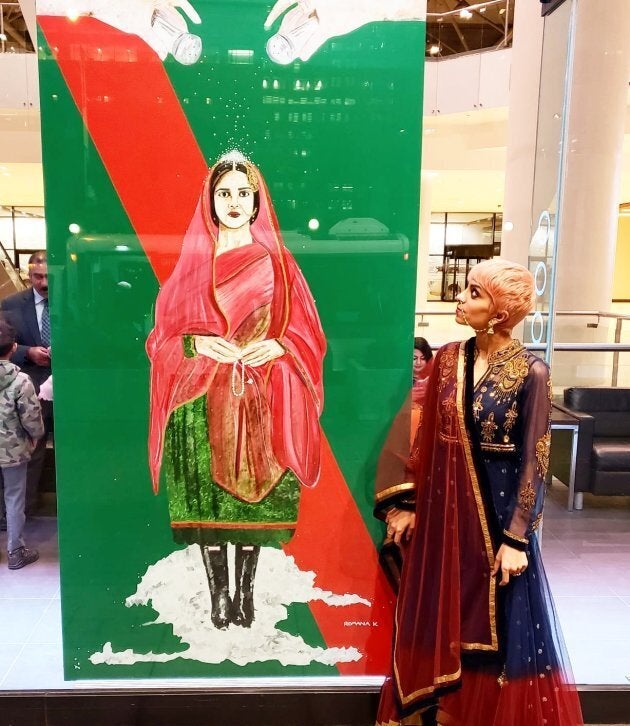

A striking portrait of a Muslim woman draped in a red and green shalwar kameez is in full display in a window at Toronto's Metro Convention Centre. The woman stands before an Ismaili flag as salt from two shakers trickles onto her head, almost like a tiny, concentrated snowfall.
"She's an immigrant Muslim woman, dressed up for Khushali," said the artist Romana Kassam. "She's standing very defenceless. The salt represents colonization: the price you pay to fit into a new country, to become part of this multicultural mosaic, which is a beautiful thing but sometimes it can come at a cost. We [immigrants] come here and we're so open and vulnerable, almost like an open wound. And then the "salt" [the overarching North American culture], can seep into our skin and can burn."
Kassam, an Ismaili Toronto-based artist, knows this duality all too well. And her artwork, which she was commissioned to paint by a local agency to auction off to raise money for the Daily Bread Food Bank in Toronto, is a full circle moment for Kassam.
Born to Ismaili parents who immigrated from Tanzania in the 1970s, Kassam spent her early upbringing in Thorncliffe Park, an east Toronto neighbourhood with a predominant Ismaili community. Ismailis are Shia Muslims who live in over 25 countries, scattered across the globe.
Kassam felt very comfortable in Thorncliffe Park, where she was surrounded by familiar faces and could easily speak Kachi, her parent's mother tongue, which is a Gujarati dialect.

"We felt safe in Thorncliffe," she said. "All of our neighbours were Ismailis. There was a mall across from us and going there felt like going to Jamatkhana [a place of worship for Ismailis]."
She and other Ismaili children would learn cultural traditions and dances such as Raas, or Dandiya Raas, a traditional folk dance from Gujarat and Rajasthan India that were hosted inside her public school after hours.
She would perform these dances during annual Khushali celebrations — the most important day of the Ismaili calendar year.
Khushali is the celebration of the birthday of the Ismaili communities' living Imam, His Highness Prince Karim Aga Khan. Every December 13th, Ismailis gather in a Jamatkhana (colloquially known as Khane) to celebrate the Aga Khan.
"We'd put on our fanciest clothes and everyone would congregate in their respective Khane," said Kassam. "We'd put on a variety show, dance Dandiya Raas and eat biriyani and cake, and drink sharbat and chai. It was the one time of the year that you knew everyone in the community was going to make an appearance."

But that all changed when she was seven years old and her family moved to Markham, Ont., a suburb north of Toronto that lacked the same diversity as Thorncliffe Park in the early 1980s.
Kassam said she was one of two ethnic kids in her class in Markham, which was a very isolating experience.
"I felt different, I felt the contrast. I went from being able to speak my language in class to no one being able to relate to Kachi," said the artist. "The only other ethnic girl in my class became my best friend."
And it was here where Kassam's desire to fit in prompted her to implore her parents to celebrate Christmas — something the family had not done previously.
"In Grade 2, when we moved to Markham, everyone was celebrating Christmas," said the now 34-year-old. "I begged my parents to buy me a Christmas tree. We needed to have the tree to belong.
She said her parents were rather reluctant to give into her Christmas wishes, but compromised by buying her and her twin sister a tiny desktop tree. The decorations had to be red and green, which are the colours of the Ismaili flag, noted Kassam.
Their family's new tradition, begrudgingly celebrated by her parents, turned into "Khumas" — an amalgamation of Christmas and Khushali. Her parents agreed to put up Christmas lights, but only in red and green colours, and their "Khumas" tree would go up on Dec. 1 and be taken down after Khushali on Dec.13.

"Our Khushali gifts were given to us by 'Mowla Bapa' [a devotional term referencing the Aga Khan] and not Santa, but were wrapped in Christmas paper. And we'd be allowed to open them on Dec. 13 every year," she said. "When kids at school would ask what I got for Christmas, I wouldn't tell them I opened my gifts on Dec. 13 and that we didn't celebrate Christmas. I just wanted to fit in."
She spent those first years in Markham still attending Khane and performing traditional dances. But as she transitioned into her teen years, her desire to fit in and honour her own developing tastes and personality grew, and she found that celebrating her ethnic culture and traditions started to weigh on her.
More from HuffPost Canada:
"By Grade 8, I didn't want to wear Indian clothes and or do the dances. I was into hip hop and R&B by then," she said. "As I got older, I rebelled. One year, I staged a coup during Khushali and brought other kids with me to dance to [the hip-hop song] 'No Diggity.' We wore baggy clothes, and dark lipstick, the whole nine."
During those years, Kassam struggled to identify where she belonged. Her family would celebrate Khushali and she'd rush home from school to get ready for those celebrations if Dec. 13 fell on a week day. But then her school would break for two weeks at Christmas — which her family didn't celebrate. It didn't seem right to her.
"I remember feeling so bored on Christmas Day because we didn't celebrate," she said. "But then when my cultural celebrations would take place, we'd have to rush home from school to attend all the festivities. We didn't get time off school. I remember feeling so annoyed. Like, did we even matter in this country?"

Now an adult, Kassam has grown to realize that she does in fact matter to this country, while also understanding the importance of Khushali and her culture and identity.
"While I recognize the need to belong, I also know now the importance of honouring my own traditions and culture," said Kassam. "Unlike in the '70s and '80s when our parents first immigrated, when we were willing to do whatever it took to fit in, our stories are now finally being profiled, our traditions are being acknowledged, and it's our responsibility to honour and share it. So now, I celebrate Khushali as Khushali and that's good enough. More than good enough."
Listen: Our podcast, "Born & Raised: Food," tells stories of food and family from second-gen Canadians. Subscribe on Apple Podcasts or Google Podcasts. Story continues below.
Born And Raised is an ongoing series by HuffPost Canada that shares the experiences of second-generation Canadians. Part reflection, part storytelling, this series on the children of immigrants explores what it means to be born and raised in Canada. We want to hear your stories — join the conversation on Twitter at #BornandRaised or send us an email at bornandraised@huffpost.com.
Also on HuffPost: